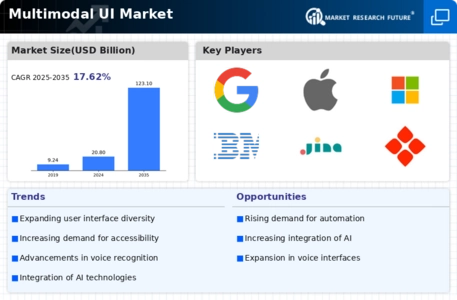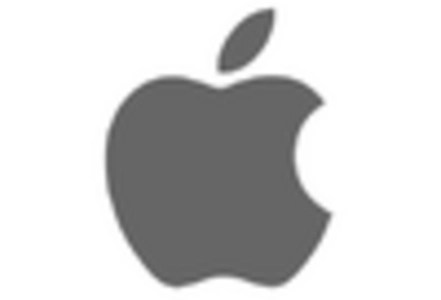-
EXECUTIVE SUMMARY
-
1.1.
-
Market Attractiveness Analysis
-
By Technology
-
1.1.3.
-
Global Multimodal UI Market, By Component
-
Global Multimodal UI Market,
-
Global Multimodal UI Market, By End Use Vertical
-
Global Multimodal UI Market, by Region
-
MARKET INTRODUCTION
-
Definition
-
Scope of the Study
-
Market Structure
-
Key Buying Criteria
-
Macro Factor Indicator
-
Analysis
-
3.
-
RESEARCH METHODOLOGY
-
3.1.
-
Research Process
-
3.2.
-
Primary Research
-
3.3.
-
Secondary Research
-
3.4.
-
Market Size Estimation
-
3.5.
-
Forecast Model
-
3.6.
-
List of Assumptions
-
4.
-
MARKET DYNAMICS
-
4.1.
-
Introduction
-
4.2.
-
Drivers
-
4.2.1.
-
High penetration rate of smart devices
-
analysis
-
4.3.
-
Restraints
-
4.3.1.
-
Technical complexity with respect to interference
-
development in IoT and NLP
-
Growing popularity of virtual assistance
-
Driver impact
-
Variation in user experience
-
Restraint impact analysis
-
Opportunities
- Recent
-
Covid-19 Impact Analysis
- Covid 1
- Covid 2
- Covid 3
-
COVID-19 IMPACT ON SUPPLY CHAIN DELAYSMARKET FACTOR
-
ANALYSIS
-
5.1.
-
Value Chain Analysis/Supply Chain Analysis
-
Porter’s Five Forces Model
- Bargaining Power of Suppliers
- Bargaining Power
-
of Buyers
-
5.2.3.
-
Threat of New Entrants
-
5.2.4.
-
Threat of Substitutes
-
5.2.5.
-
Intensity of Rivalry
-
6.
-
GLOBAL MULTIMODAL UI MARKET, BY COMPONENT
-
Introduction
-
Hardware
- Microphone
- Sensor
- Camera
- Others
-
Software
-
Service
-
GLOBAL MULTIMODAL UI MARKET, BY TECHNOLOGY
-
Introduction
-
Voice Recognition
-
Text Input
-
Gesture Recognition
-
Visual
-
Others
-
GLOBAL MULTIMODAL
-
UI MARKET, BY END USE VERTICAL
-
Introduction
-
Automotive
-
Healthcare
-
Entertainment
-
IT & Telecommunication
-
Consumer Electronics
-
Education
-
Retail
-
Others
-
GLOBAL MULTIMODAL UI MARKET SIZE ESTIMATION &
-
FORECAST, BY REGION
-
9.1.
-
Introduction
-
9.2.
-
North America
-
9.2.1.
-
Market Estimates & Forecast, by Country, 2019-2032
-
9.2.3.
-
Market Estimates & Forecast, By Component,
-
Market Estimates & Forecast, By Technology, 2019-2032
-
Vertical, 2019-2032
-
9.2.5.
-
US
-
9.2.5.1.
-
Market Estimates & Forecast, By End Use
-
Market Estimates & Forecast, By Component, 2019-2032
-
9.2.5.3.
-
Market Estimates & Forecast, By Technology,
-
Market Estimates & Forecast, By End Use Vertical, 2019-2032
-
Forecast, By Component, 2019-2032
-
& Forecast, By End Use Vertical, 2019-2032
-
9.2.7.2.
-
Canada
-
Market Estimates &
-
Market Estimates & Forecast, By Technology, 2019-2032
-
Market Estimates
-
Mexico
-
Market Estimates & Forecast, By Component,
-
Market Estimates & Forecast, By Technology, 2019-2032
-
Use Vertical, 2019-2032
-
& Forecast, By Component, 2019-2032
-
& Forecast, By End Use Vertical, 2019-2032
-
9.3.5.2.
-
Market Estimates & Forecast, By End
-
Europe
- Market Estimates & Forecast, by Country, 2019-2032
- Market Estimates
- Market Estimates & Forecast, By Technology, 2019-2032
- Market Estimates
- UK
-
Market Estimates & Forecast, By Technology, 2019-2032
-
Use Vertical, 2019-2032
-
& Forecast, By Technology, 2019-2032
-
9.3.7.
-
France
-
9.3.7.1.
-
Market Estimates & Forecast, By End
-
Germany
-
Market Estimates & Forecast, By Component, 2019-2032
-
Market Estimates
-
Market Estimates & Forecast, By End Use Vertical,
-
Market Estimates & Forecast, By Component, 2019-2032
-
9.3.7.3.
-
Market Estimates & Forecast, By Technology,
-
Market Estimates & Forecast, By End Use Vertical, 2019-2032
-
Forecast, By Component, 2019-2032
-
& Forecast, By End Use Vertical, 2019-2032
-
9.3.9.2.
-
Italy
-
Market Estimates &
-
Market Estimates & Forecast, By Technology, 2019-2032
-
Market Estimates
-
Spain
-
Market Estimates & Forecast, By Component,
-
Market Estimates & Forecast, By Technology, 2019-2032
-
Use Vertical, 2019-2032
-
9.3.10.2.
-
Market Estimates & Forecast, By End
-
Rest of Europe
-
Market Estimates & Forecast, By Component,
-
Market Estimates & Forecast, By Technology, 2019-2032
-
Use Vertical, 2019-2032
-
& Forecast, By Component, 2019-2032
-
& Forecast, By End Use Vertical, 2019-2032
-
9.4.5.2.
-
Market Estimates & Forecast, By End
-
Asia-Pacific
- Market Estimates & Forecast, by Country, 2019-2032
- Market Estimates
- Market Estimates & Forecast, By Technology, 2019-2032
- Market Estimates
- China
-
Market Estimates & Forecast, By Technology, 2019-2032
-
Use Vertical, 2019-2032
-
& Forecast, By Technology, 2019-2032
-
9.4.7.
-
India
-
9.4.7.1.
-
Market Estimates & Forecast, By End
-
Japan
-
Market Estimates & Forecast, By Component, 2019-2032
-
Market Estimates
-
Market Estimates & Forecast, By End Use Vertical,
-
Market Estimates & Forecast, By Component, 2019-2032
-
9.4.7.3.
-
Market Estimates & Forecast, By Technology,
-
Market Estimates & Forecast, By End Use Vertical, 2019-2032
-
Forecast, By Component, 2019-2032
-
& Forecast, By End Use Vertical, 2019-2032
-
9.4.9.2.
-
Australia
-
Market Estimates &
-
Market Estimates & Forecast, By Technology, 2019-2032
-
Market Estimates
-
Rest of Asia-Pacific
-
Market Estimates & Forecast, By Component,
-
Market Estimates & Forecast, By Technology, 2019-2032
-
Use Vertical, 2019-2032
-
& Forecast, By Technology, 2019-2032
-
9.5.4.
-
Middle East
-
9.5.4.1.
-
Market Estimates & Forecast, By End
-
Rest of the World
- Market Estimates & Forecast, By Component, 2019-2032
- Market Estimates
- Market Estimates & Forecast, By End Use Vertical,
-
Market Estimates & Forecast, By Component, 2019-2032
-
9.5.4.3.
-
Market Estimates & Forecast, By Technology,
-
Market Estimates & Forecast, By End Use Vertical, 2019-2032
-
Forecast, By Component, 2019-2032
-
& Forecast, By End Use Vertical, 2019-2032
-
9.5.6.2.
-
Africa
-
Market Estimates &
-
Market Estimates & Forecast, By Technology, 2019-2032
-
Market Estimates
-
Latin America
-
Market Estimates & Forecast, By Component,
-
Market Estimates & Forecast, By Technology, 2019-2032
-
Use Vertical, 2019-2032
-
Market Estimates & Forecast, By End
-
COMPETITIVE LANDSCAPE
-
Introduction
-
Key Developments & Growth Strategies
-
Competitor Benchmarking
-
Vendor Share Analysis,
-
11.
-
COMPANY PROFILES
-
11.1.
-
Amazon
-
11.2.
-
Google
-
11.3.
-
Apple
-
11.4.
-
Microsoft
-
11.5.
-
Leap Motion
-
11.6.
-
IBM
-
Jina
-
AI
-
Appen
-
OpenAI
-
Siemens
-
Company 11
-
Company 12
-
Company 13
-
Company 14
-
Company 15
- Company Overview
- Financial Overview
- Solution/Services
-
Offered
-
11.15.4.
-
Key Developments
-
11.15.5.
-
SWOT Analysis
-
11.15.6.
-
Key Strategies
-
LIST
-
OF TABLES
-
TABLE
-
GLOBAL MULTIMODAL UI MARKET, BY COMPONENT, 2018–2032 (USD MILLION)
-
GLOBAL MULTIMODAL
-
UI MARKET, BY TECHNOLOGY, 2018–2032 (USD MILLION)
-
GLOBAL MULTIMODAL UI MARKET, BY END USE VERTICAL,
-
GLOBAL MULTIMODAL UI MARKET, BY REGION, 2018–2032 (USD
-
MILLION)
-
TABLE
-
NORTH AMERICA MULTIMODAL UI MARKET, BY COUNTRY, 2018–2032 (USD MILLION)
-
NORTH
-
AMERICA MULTIMODAL UI MARKET, BY COMPONENT, 2018–2032 (USD MILLION)
-
NORTH AMERICA
-
MULTIMODAL UI MARKET, BY TECHNOLOGY, 2018–2032 (USD MILLION)
-
NORTH AMERICA MULTIMODAL
-
UI MARKET, BY END USE VERTICAL, 2018–2032 (USD MILLION)
-
US MULTIMODAL UI MARKET,
-
BY COMPONENT, 2018–2032 (USD MILLION)
-
US MULTIMODAL UI MARKET, BY TECHNOLOGY,
-
US MULTIMODAL UI MARKET, BY END USE VERTICAL, 2018–2032
-
(USD MILLION)
-
TABLE
-
CANADA MULTIMODAL UI MARKET, BY COMPONENT, 2018–2032 (USD MILLION)
-
CANADA MULTIMODAL
-
UI MARKET, BY TECHNOLOGY, 2018–2032 (USD MILLION)
-
CANADA MULTIMODAL UI MARKET, BY END USE
-
VERTICAL, 2018–2032 (USD MILLION)
-
MEXICO MULTIMODAL UI MARKET, BY COMPONENT, 2018–2032
-
(USD MILLION)
-
TABLE
-
MEXICO MULTIMODAL UI MARKET, BY TECHNOLOGY, 2018–2032 (USD MILLION)
-
MEXICO MULTIMODAL
-
UI MARKET, BY END USE VERTICAL, 2018–2032 (USD MILLION)
-
EUROPE MULTIMODAL UI
-
MARKET, BY COUNTRY, 2018–2032 (USD MILLION)
-
EUROPE MULTIMODAL UI MARKET, BY COMPONENT,
-
EUROPE MULTIMODAL UI MARKET, BY TECHNOLOGY, 2018–2032
-
(USD MILLION)
-
TABLE
-
EUROPE MULTIMODAL UI MARKET, BY END USE VERTICAL, 2018–2032 (USD MILLION)
-
GERMANY
-
MULTIMODAL UI MARKET, BY COMPONENT, 2018–2032 (USD MILLION)
-
GERMANY MULTIMODAL UI
-
MARKET, BY TECHNOLOGY, 2018–2032 (USD MILLION)
-
GERMANY MULTIMODAL UI MARKET, BY END USE
-
VERTICAL, 2018–2032 (USD MILLION)
-
UK MULTIMODAL UI MARKET, BY COMPONENT, 2018–2032
-
(USD MILLION)
-
TABLE
-
UK MULTIMODAL UI MARKET, BY TECHNOLOGY, 2018–2032 (USD MILLION)
-
UK MULTIMODAL
-
UI MARKET, BY END USE VERTICAL, 2018–2032 (USD MILLION)
-
FRANCE MULTIMODAL UI
-
MARKET, BY COMPONENT, 2018–2032 (USD MILLION)
-
FRANCE MULTIMODAL UI MARKET, BY TECHNOLOGY,
-
FRANCE MULTIMODAL UI MARKET, BY END USE VERTICAL, 2018–2032
-
(USD MILLION)
-
TABLE
-
ITALY MULTIMODAL UI MARKET, BY COMPONENT, 2018–2032 (USD MILLION)
-
ITALY MULTIMODAL
-
UI MARKET, BY TECHNOLOGY, 2018–2032 (USD MILLION)
-
ITALY MULTIMODAL UI MARKET, BY END USE VERTICAL,
-
SPAIN MULTIMODAL UI MARKET, BY COMPONENT, 2018–2032
-
(USD MILLION)
-
TABLE
-
SPAIN MULTIMODAL UI MARKET, BY TECHNOLOGY, 2018–2032 (USD MILLION)
-
SPAIN MULTIMODAL
-
UI MARKET, BY END USE VERTICAL, 2018–2032 (USD MILLION)
-
REST OF EUROPE MULTIMODAL
-
UI MARKET, BY COMPONENT, 2018–2032 (USD MILLION)
-
REST OF EUROPE MULTIMODAL UI MARKET, BY
-
TECHNOLOGY, 2018–2032 (USD MILLION)
-
REST OF EUROPE MULTIMODAL UI MARKET, BY
-
END USE VERTICAL, 2018–2032 (USD MILLION)
-
ASIA PACIFIC MULTIMODAL UI MARKET, BY COUNTRY,
-
ASIA PACIFIC MULTIMODAL UI MARKET, BY COMPONENT, 2018–2032
-
(USD MILLION)
-
TABLE
-
ASIA PACIFIC MULTIMODAL UI MARKET, BY TECHNOLOGY, 2018–2032 (USD MILLION)
-
ASIA
-
PACIFIC MULTIMODAL UI MARKET, BY END USE VERTICAL, 2018–2032 (USD MILLION)
-
CHINA
-
MULTIMODAL UI MARKET, BY COMPONENT, 2018–2032 (USD MILLION)
-
CHINA MULTIMODAL UI
-
MARKET, BY TECHNOLOGY, 2018–2032 (USD MILLION)
-
CHINA MULTIMODAL UI MARKET, BY END USE VERTICAL,
-
INDIA MULTIMODAL UI MARKET, BY COMPONENT, 2018–2032
-
(USD MILLION)
-
TABLE
-
INDIA MULTIMODAL UI MARKET, BY TECHNOLOGY, 2018–2032 (USD MILLION)
-
INDIA MULTIMODAL
-
UI MARKET, BY END USE VERTICAL, 2018–2032 (USD MILLION)
-
JAPAN MULTIMODAL UI
-
MARKET, BY COMPONENT, 2018–2032 (USD MILLION)
-
JAPAN MULTIMODAL UI MARKET, BY TECHNOLOGY,
-
JAPAN MULTIMODAL UI MARKET, BY END USE VERTICAL, 2018–2032
-
(USD MILLION)
-
TABLE
-
AUSTRALIA MULTIMODAL UI MARKET, BY COMPONENT, 2018–2032 (USD MILLION)
-
AUSTRALIA MULTIMODAL
-
UI MARKET, BY TECHNOLOGY, 2018–2032 (USD MILLION)
-
AUSTRALIA MULTIMODAL UI MARKET, BY END USE
-
VERTICAL, 2018–2032 (USD MILLION)
-
REST FO ASIA PACIFIC MULTIMODAL UI MARKET, BY COMPONENT,
-
REST FO ASIA PACIFIC MULTIMODAL UI MARKET, BY TECHNOLOGY,
-
REST FO ASIA PACIFIC MULTIMODAL UI MARKET, BY END USE VERTICAL,
-
REST FO THE WORLD MULTIMODAL UI MARKET, BY COMPONENT, 2018–2032
-
(USD MILLION)
-
TABLE
-
REST FO THE WORLD MULTIMODAL UI MARKET, BY TECHNOLOGY, 2018–2032 (USD MILLION)
-
REST
-
FO THE WORLD MULTIMODAL UI MARKET, BY END USE VERTICAL, 2018–2032 (USD MILLION)
-
MIDDLE
-
EAST MULTIMODAL UI MARKET, BY COMPONENT, 2018–2032 (USD MILLION)
-
MIDDLE EAST
-
MULTIMODAL UI MARKET, BY TECHNOLOGY, 2018–2032 (USD MILLION)
-
MIDDLE EAST MULTIMODAL
-
UI MARKET, BY END USE VERTICAL, 2018–2032 (USD MILLION)
-
AFRICA MULTIMODAL UI
-
MARKET, BY COMPONENT, 2018–2032 (USD MILLION)
-
AFRICA MULTIMODAL UI MARKET, BY TECHNOLOGY,
-
AFRICA MULTIMODAL UI MARKET, BY END USE VERTICAL, 2018–2032
-
(USD MILLION)
-
TABLE
-
SOUTH AMERICA MULTIMODAL UI MARKET, BY COMPONENT, 2018–2032 (USD MILLION)
-
SOUTH
-
AMERICA MULTIMODAL UI MARKET, BY TECHNOLOGY, 2018–2032 (USD MILLION)
-
SOUTH AMERICA
-
MULTIMODAL UI MARKET, BY END USE VERTICAL, 2018–2032 (USD MILLION)
-
PARTNERSHIPS/AGREEMENTS/CONTRACTS/COLLABORATIONS
-
BUSINESS
-
EXPANSIONS/ACQUISITIONS
-
PRODUCT LAUNCHES/DEVELOPMENTS
-
AMAZON: PRODUCTS OFFERED
-
AMAZON: KEY DEVELOPMENT
-
GOOGLE: PRODUCTS
-
OFFERED
-
TABLE
-
GOOGLE: KEY DEVELOPMENT
-
APPLE: PRODUCTS OFFERED
-
APPLE: KEY DEVELOPMENT
-
MICROSOFT: PRODUCTS
-
OFFERED
-
TABLE
-
MICROSOFT: KEY DEVELOPMENT
-
LEAP MOTION: PRODUCTS OFFERED
-
LEAP MOTION: KEY DEVELOPMENT
-
IBM: PRODUCTS OFFERED
-
IBM:
-
KEY DEVELOPMENT
-
TABLE
-
JINA AI: PRODUCTS OFFERED
-
JINA AI: KEY DEVELOPMENT
-
APPEN: PRODUCTS OFFERED
-
APPEN: KEY DEVELOPMENT
-
OPENAI: PRODUCTS
-
OFFERED
-
TABLE
-
OPENAI: KEY DEVELOPMENT
-
SIEMENS: PRODUCTS OFFERED
-
SIEMENS: KEY DEVELOPMENT
-
COMPANY 11: PRODUCTS
-
OFFERED
-
TABLE
-
COMPANY 11: KEY DEVELOPMENT
-
COMPANY 12: PRODUCTS OFFERED
-
COMPANY 12: KEY DEVELOPMENT
-
COMPANY 13: PRODUCTS
-
OFFERED
-
TABLE
-
COMPANY 13: KEY DEVELOPMENT
-
COMPANY 14: PRODUCTS OFFERED
-
COMPANY 14: KEY DEVELOPMENT
-
COMPANY 15: PRODUCTS
-
OFFERED
-
TABLE
-
COMPANY 15: KEY DEVELOPMENT
-
LIST
-
OF FIGURES
-
FIGURE
-
MARKET SYNOPSIS
-
FIGURE
-
MARKET STRUCTURE: GLOBAL MULTIMODAL UI MARKET
-
BOTTOM-UP AND TOP-DOWN APPROACHES
-
MARKET DYNAMIC
-
ANALYSIS OF THE GLOBAL MULTIMODAL UI MARKET
-
DRIVER IMPACT ANALYSIS
-
RESTRAINTS IMPACT ANALYSIS
-
GLOBAL
-
MULTIMODAL UI MARKET: VALUE CHAIN
-
GLOBAL MULTIMODAL UI MARKET, BY COMPONENT, 2022 (% SHARE)
-
GLOBAL
-
MULTIMODAL UI MARKET, BY COMPONENT, 2022 VS 2032 (USD MILLION)
-
GLOBAL MULTIMODAL UI
-
MARKET, BY TECHNOLOGY, 2022 (% SHARE)
-
GLOBAL MULTIMODAL UI MARKET, BY TECHNOLOGY, 2022
-
VS 2032 (USD MILLION)
-
FIGURE
-
GLOBAL MULTIMODAL UI MARKET, BY END USE VERTICAL, 2022 (% SHARE)
-
GLOBAL MULTIMODAL UI
-
MARKET, BY END USE VERTICAL, 2022 VS 2032 (USD MILLION)
-
GLOBAL MULTIMODAL UI MARKET, BY REGION,
-
FIGURE
-
GLOBAL MULTIMODAL UI MARKET, BY REGION, 2022 VS 2032 (USD MILLION)
-
NORTH AMERICA
-
MULTIMODAL UI MARKET, BY COUNTRY, 2022 (% SHARE)
-
NORTH AMERICA MULTIMODAL UI MARKET, BY
-
COUNTRY, 2022 VS 2032 (USD MILLION)
-
NORTH AMERICA MULTIMODAL UI MARKET, BY COMPONENT,
-
NORTH AMERICA MULTIMODAL UI MARKET, BY TECHNOLOGY, 2019-2032
-
(USD MILLION)
-
FIGURE
-
NORTH AMERICA MULTIMODAL UI MARKET, BY END USE VERTICAL, 2019-2032 (USD MILLION)
-
FIGURE 21
-
EUROPE MULTIMODAL UI MARKET, BY COUNTRY, 2022 (% SHARE)
-
EUROPE MULTIMODAL UI MARKET, BY COUNTRY,
-
EUROPE MULTIMODAL UI MARKET, BY COMPONENT, 2019-2032 (USD
-
MILLION)
-
FIGURE
-
EUROPE MULTIMODAL UI MARKET, BY TECHNOLOGY, 2019-2032 (USD MILLION)
-
EUROPE MULTIMODAL
-
UI MARKET, BY END USE VERTICAL, 2019-2032 (USD MILLION)
-
ASIA PACIFIC MULTIMODAL UI MARKET, BY COUNTRY,
-
FIGURE
-
ASIA PACIFIC MULTIMODAL UI MARKET, BY COUNTRY, 2022 VS 2032 (USD MILLION)
-
ASIA PACIFIC
-
MULTIMODAL UI MARKET, BY COMPONENT, 2019-2032 (USD MILLION)
-
ASIA PACIFIC MULTIMODAL UI MARKET, BY TECHNOLOGY,
-
ASIA PACIFIC MULTIMODAL UI MARKET, BY END USE VERTICAL, 2019-2032
-
(USD MILLION)
-
FIGURE
-
REST OF THE WORLD MULTIMODAL UI MARKET, BY COMPONENT, 2019-2032 (USD MILLION)
-
FIGURE 32
-
REST OF THE WORLD MULTIMODAL UI MARKET, BY TECHNOLOGY, 2019-2032 (USD MILLION)
-
REST OF THE
-
WORLD MULTIMODAL UI MARKET, BY END USE VERTICAL, 2019-2032 (USD MILLION)
-
MIDDLE EAST
-
MULTIMODAL UI MARKET, BY COMPONENT, 2019-2032 (USD MILLION)
-
MIDDLE EAST MULTIMODAL UI MARKET, BY TECHNOLOGY,
-
MIDDLE EAST MULTIMODAL UI MARKET, BY END USE VERTICAL, 2019-2032
-
(USD MILLION)
-
FIGURE
-
AFRICA MULTIMODAL UI MARKET, BY COMPONENT, 2019-2032 (USD MILLION)
-
AFRICA MULTIMODAL
-
UI MARKET, BY TECHNOLOGY, 2019-2032 (USD MILLION)
-
AFRICA MULTIMODAL UI MARKET, BY END USE
-
VERTICAL, 2019-2032 (USD MILLION)
-
SOUTH AMERICA MULTIMODAL UI MARKET, BY COMPONENT,
-
SOUTH AMERICA MULTIMODAL UI MARKET, BY TECHNOLOGY, 2019-2032
-
(USD MILLION)
-
FIGURE
-
SOUTH AMERICA MULTIMODAL UI MARKET, BY END USE VERTICAL, 2019-2032 (USD MILLION)
-
FIGURE 43
-
GLOBAL MULTIMODAL UI MARKET: COMPETITIVE BENCHMARKING
-
VENDOR SHARE ANALYSIS, 2022 (%)
-
AMAZON: FINANCIAL
-
OVERVIEW SNAPSHOT
-
FIGURE
-
AMAZON: SWOT ANALYSIS
-
GOOGLE: FINANCIAL OVERVIEW SNAPSHOT
-
GOOGLE: SWOT ANALYSIS
-
APPLE: FINANCIAL OVERVIEW
-
SNAPSHOT
-
FIGURE
-
APPLE: SWOT ANALYSIS
-
MICROSOFT: FINANCIAL OVERVIEW SNAPSHOT
-
MICROSOFT: SWOT ANALYSIS
-
LEAP MOTION:
-
FINANCIAL OVERVIEW SNAPSHOT
-
LEAP MOTION: SWOT ANALYSIS
-
IBM: FINANCIAL OVERVIEW SNAPSHOT
-
IBM: SWOT ANALYSIS
-
JINA AI: FINANCIAL
-
OVERVIEW SNAPSHOT
-
FIGURE
-
JINA AI: SWOT ANALYSIS
-
APPEN: FINANCIAL OVERVIEW SNAPSHOT
-
APPEN: SWOT ANALYSIS
-
OPENAI: FINANCIAL OVERVIEW
-
SNAPSHOT
-
FIGURE
-
OPENAI: SWOT ANALYSIS
-
SIEMENS: FINANCIAL OVERVIEW SNAPSHOT
-
COMPANY 11 : FINANCIAL OVERVIEW SNAPSHOT
-
COMPANY 11:
-
SWOT ANALYSIS
-
FIGURE
-
COMPANY 12: FINANCIAL OVERVIEW SNAPSHOT
-
COMPANY 12: SWOT ANALYSIS
-
COMPANY 13: FINANCIAL
-
OVERVIEW SNAPSHOT
-
FIGURE
-
COMPANY 13: SWOT ANALYSIS
-
COMPANY 14: FINANCIAL OVERVIEW SNAPSHOT
-
COMPANY 14: SWOT ANALYSIS
-
COMPANY 15:
-
FINANCIAL OVERVIEW SNAPSHOT
-
COMPANY 15: SWOT ANALYSIS
-
NOTE:
-
This table of content is tentative and subject to change
-
as the research progresses.
-
In section 15, only the top 15 companies will be profiled. Each company
-
will be profiled based on the Market Overview, Financials, Service Portfolio, Business
-
Strategies, and Recent Developments parameters.
-
The companies are selected based on two broad criteria¬–
-
strength of product portfolio and excellence in business strategies.
-
Key parameters considered for
-
evaluating strength of the vendor’s product portfolio are industry experience,
-
product capabilities/features, innovations/R&D investment, flexibility to customize
-
the product, ability to integrate with other systems, pre- and post-sale services,
-
and customer ratings/feedback.
-
Key parameters considered for evaluating a vendor’s excellence
-
in business strategy are its market share, global presence, customer base, partner
-
ecosystem (technology alliances/resellers/distributors), acquisitions, and marketing
-
strategies/investments.
-
The financial details of the company cannot be provided if the information
-
is not available in the public domain and or from reliable sources.












Leave a Comment